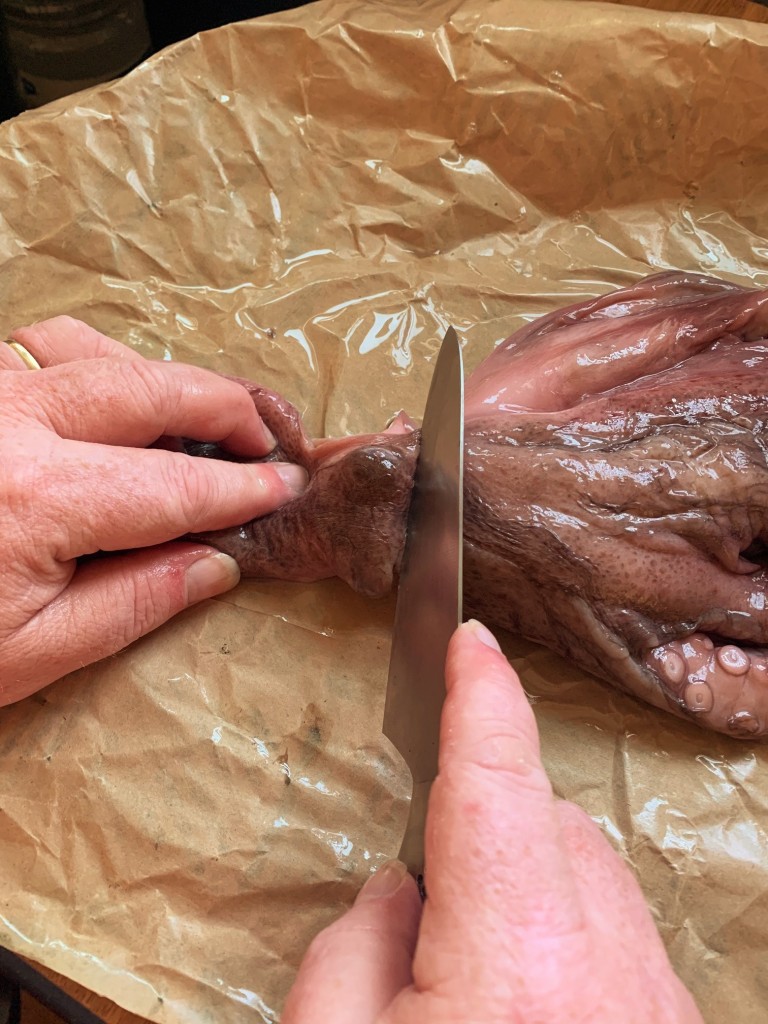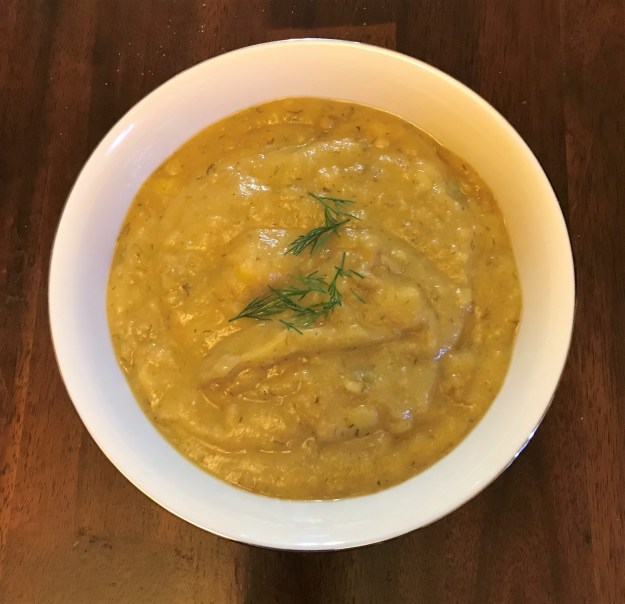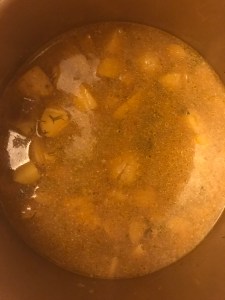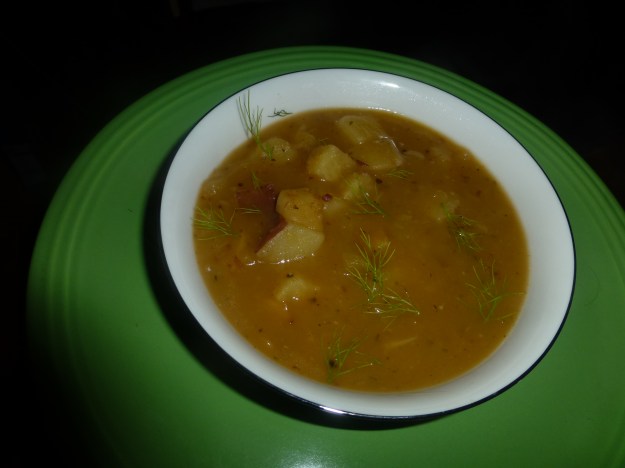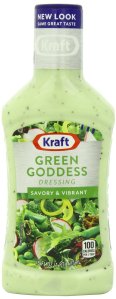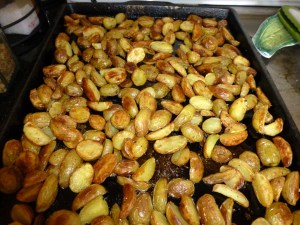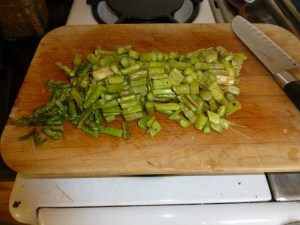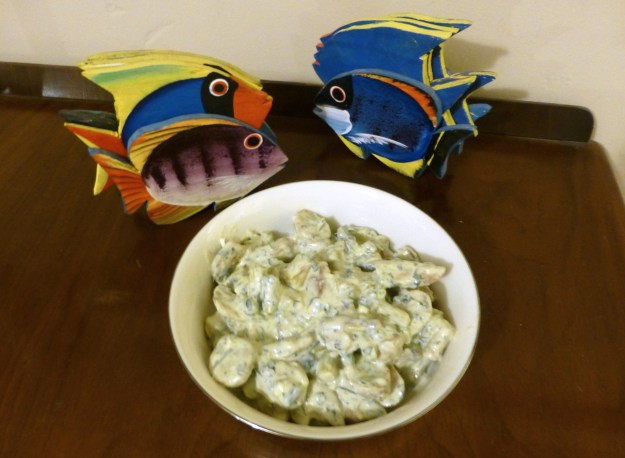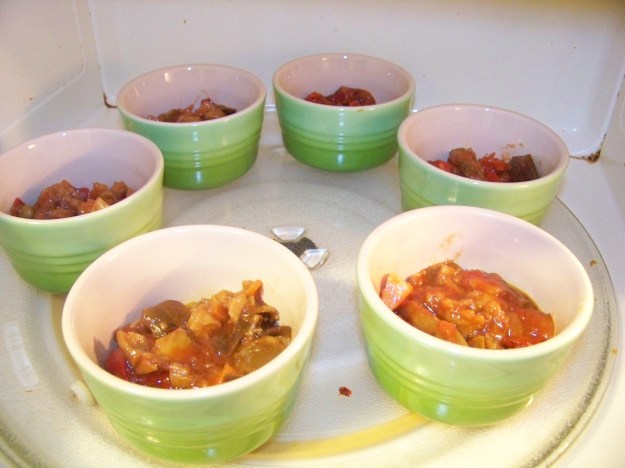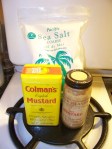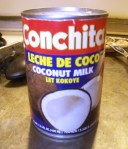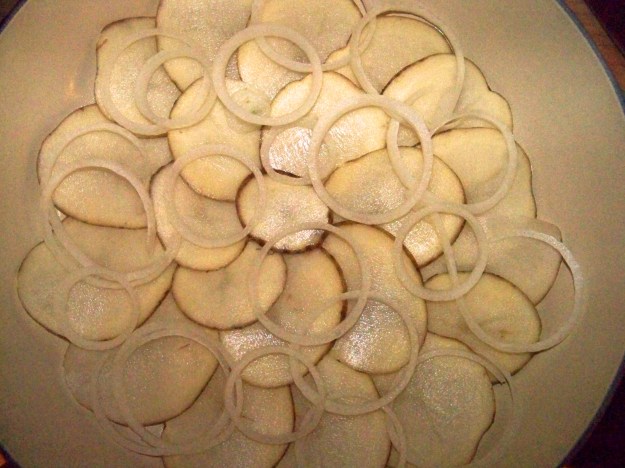
Chef Marie (l.) and cousin Sheryl (r.) performing the Ritual Admiration of the Tourtière ceremony last December.
My great-great-great-great-great grandfather Pierre would disown me.
The very idea of making a vegetable tourtière would be as alien and outlandish to him as, um, reading Gwyneth Paltrow’s Twitter feed. As every Canadian knows, the only way to make this traditional Québécois holiday dish is with pork. Or a blend of pork and another meat. Or wild game. Or maybe the occasional bird. Spice, too, is highly variable from region to region. In fact, Susan Semenak of the Montreal Gazette suggests that each particular recipe may be a “tell” as to one’s genealogy. As you might have intuited, it’s quite the subject of debate, and if you thought Canadians are unfailingly polite, donnybrooks over the dish’s “authenticity” will disabuse you of that notion for good. [Although, to be fair, the CBC Radio host in the previous link responded individually — and no doubt courteously — to all the hate mail she got over a network story on the subject.]
I had a delicious tourtière in Vancouver this past holiday season (see picture at top), but for Lent this year, we’re all vegetarian all the time, so salty tasty pig parts are right out. In my scent memory, tourtière was always more redolent of warm winter spices (cloves, cinnamon, nutmeg) than pork, though, so I figured if I got the seasoning right and the filling didn’t clash, I could pull a decent vegan version together. Since I’ve always found a grilled portabello cap an acceptable substitute for a burger, I started with mushrooms. Potatoes and onions could make the leap from the trad version to this one without effort, but it still seemed to be missing something. I knew that certain ersatz meat-like products are made with lentils, and I had the dregs of a box of lentilles du Puy in the pantry, so in they went. If nothing else, at least they were French. Plus, I love their peppery bite.
[Sidebar: Le Puy lentils ain’t your standard ranch stash legumes. Known as “the poor man’s caviar” and “the pearls of central France,” the lentilles vertes du Puy are sufficiently distinctive to have been awarded their own AOC, much like Champagne and Roquefort cheese. So please don’t just wander down to your local south Asian market and load up on urad dal, good though it may be. Not for this dish.]
I’m not going to lie to you: this is not the sort of recipe of which you can say, “I just tossed everything in the microvection pot, and twelve-point-four minutes later, my family and I were discussing Corsi stats for the Vegas Golden Knights while shoveling forkfuls of a storied Québécois holiday dish into our cavernous pieholes.” On the other hand, none of the steps require a whole lot of sophistication or attention, so it’s pretty easy to pull this together while you are assembling your personal Death Star, extracting ink from a squid, or knitting handcuffs for children.

Tourtière in situ, avec des feuilles d’érable pour l’authenticité.
Tourtière Végétalienne
(serves 8-12)
INGREDIENTS
Tourtière Spice Blend
2 teaspoons / 12 g salt
2 teaspoons / 1 g Herbes de Provence
1 teaspoon / 1½ g thyme
½ teaspoon / 1 g cinnamon
½ teaspoon / 1 g ground ginger
½ teaspoon / 1/3 g marjoram
½ teaspoon nutmeg / 1 g (fresh ground if possible)
½ teaspoon / 1/3 g sage
½ teaspoon / 1/3 g savory
¼ teaspoon / ½ g allspice
¼ teaspoon / ½ g coriander
¼ teaspoon / 1/5 g dry mustard
⅛ teaspoon / ¼ g ground cloves
dash white pepper
Tourtière Filling
2 lb. / 1 kg potatoes, peeled, cooked, and mashed
1 lb. / 500 g crimini mushrooms
75 g dried porcini and Chilean Bolete mushroom mix (about 2 cups rehydrated, or just add another pound of fresh mushrooms)
1 cup / 200 g Le Puy French lentils, cooked (this is a type, not a brand name)
1 large onion, diced
2 ribs celery, minced
4 cloves garlic, minced
2 tbsp. / 30 ml olive oil
Tourtière Crust
12 oz. / 340 g (about 2¼ – 2½ cups) all purpose flour
½ teaspoon / 3 g salt
1 cup / 2 sticks / 225 g Earth Balance Vegan Buttery Sticks (or some other vegan shortening product)
8-12 tbsp. / 120-175 ml ice water (REALLY COLD!)
1 – 2 teaspoons / 5-10 ml vinegar
DIRECTIONS
For the Tourtière Filling:
You might want to read the directions all the way through once before leaping in; I tried to arrange several discrete steps to minimize waste of time and resources (like hot water). But if you’re doing other things in the meantime, feel free to rearrange the process to suit your schedule.
Assemble the spice blend, stir with a fork to mix, and set aside.
Rehydrate the dried mushrooms in warm water; this will take about half an hour or a bit more, depending on the mushrooms and their thickness. When they are plump, remove them from the water (reserving the water in the process) and rinse the grit off in a colander. Strain the reserved mushroom liquid through a fine sieve and set aside. [It can be used for a sauce or in stock later. It will keep in the fridge for a week, or it can be frozen for future use.] Chop the washed mushrooms and set aside in a bowl. Of course, if you are using all fresh mushrooms, you can skip this step. Wash the fresh mushrooms, chop them roughly, and set aside in a bowl.
Peel potatoes (this can be done while the mushrooms are rehydrating) and cut into quarters. Cover with about 1 – 2 inches (2½ – 5 cm) of water and boil gently in saucepan for between 15-25 minutes, until a knife slides in without resistance. Remove potatoes with slotted spoon and transfer to bowl. Mash potatoes with a pinch of salt and pepper, but no liquid (although if they are too much of a challenge, you could add 1/4 cup or 60 ml of the boiling water and give them a little bit of help).
While potatoes are boiling, rinse lentils and remove debris, if any. After potatoes have been removed from the saucepan, you can cook the lentils in the already-warm potato water, boiling gently for 20 minutes. When they are done, drain them, discarding the potato water, and set aside.
Dice onion, and add it along with the olive oil to a large pan (big enough to hold all the ingredients, which it eventually will). Brown onion, stirring occasionally, about 25 minutes or so.
While onions are browning, mince celery and garlic, setting them aside in separate bowls.
After onions have browned, increase the heat under the pan, add minced celery, and sweat it for a couple of minutes, stirring occasionally. Then stir in lentils, minced garlic and spice mix, and cook for about 2-3 more minutes. Reduce heat and fold in mushrooms; simmer, stirring occasionally, until mushrooms have softened and released their liquor, about 15 minutes. If mixture seems too dry at any point along the way, add between 2 tablespoons and 1/4 cup (30 – 60 ml) of reserved mushroom rehydrating broth. When mushrooms are cooked, fold in mashed potatoes and mix with wooden spoon so that all ingredients are distributed evenly throughout. When it’s all warm (about 5-10 minutes), taste and adjust spices as necessary. [This usually means a bit of salt and pepper, but if your palate is discerning, you may detect that one element or another of your spice blend has disappeared, so you can fix that as well. Be forewarned: cloves, cinnamon, and ginger are very assertive, so add with caution, if at all.]
Remove from heat and allow to cool at least to room temperature before filling pie.

Here’s your shortening.
DIRECTIONS
For the Tourtière Crust:
Freeze shortening overnight. Chop shortening into small chunks. Add, along with salt and flour, to food processor bowl fitted with “S” blade. Pulse until a “gravelly” dough comes together that will adhere to itself if you pinch it in your hand (think wet sand). Notice little clump at left of photo.

Not quite ready, but close.
Begin adding ice water and vinegar solution a tablespoon or two at a time, and pulsing until dough begins to have enough moisture to cohere. There’s not a great way to explain this in print, which is why there are apprentices and grandmothers. Once you feel it, you will understand. In the meantime, check this vid, and you’ll get a sense of the process. [The video version is done with a pastry cutter rather than a food processor, but you’ll see how the chef gets where she needs to go.]
IMPORTANT SIDEBAR: Keep everything as cold as you can! Warm dough is greasy and soggy dough.

Not quite a 50-50 spilt.
Empty dough from processor and mold into a round-ish lump, wrap with cling film, and pop it into the chill chest — you know it as the refrigerator — to rest for AT LEAST an hour, though overnight is even better. When dough has rested, bring it out onto your rolling surface (I used a big cutting board with a floured silicone mat on top) and cut it in half-ish (the bottom crust needs to be bigger than the top).
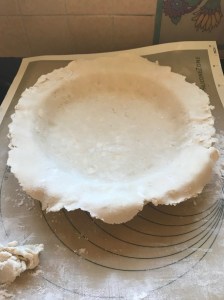
In the pan, ready to be filled.
Roll out the dough from the center outwards until you have a sufficiently large crust for the bottom, two to three inches (5 – 7.5 cm) bigger than the pan. Don’t worry about overhang; that will be incorporated later. Once bottom crust is set in pan, fill with mushroom/lentil/potato mix, making sure to distribute it evenly.
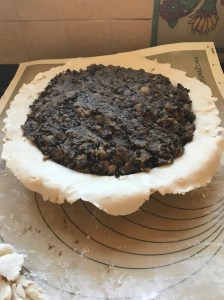
Man, I’m stuffed.
Roll out top crust and place on top. This video shows not only shows about how to crimp the dough together, it’s a useful instruction tool on how to make pie dough period (even if his version is not vegan). You’ll need to vent your tourtière just like any pie, to allow steam to escape. You may choose to cut your vents in the shape of maple leaves, or you can just poke the crust a few times with a knife or fork. Have a little fun with it; after all, you’re making pie for dinner. How cool is that?

Vented and crimped.
Bake the filled tourtière for approximately 50 minutes at 175°C / 350°F. Serve warm, or allow to cool to room temp and serve then. Mushroom gravy, a wine reduction sauce, or a vegan mustard “cream” sauce are delightful accompaniments, but they’re going to have to wait for another post, I’m afraid.

